

Nature to Nations. Premiere Date: Oct. 30 @ 9/8c Nature to Nations explores the rise of great American nations, from dynastic monarchies to participatory democracies.
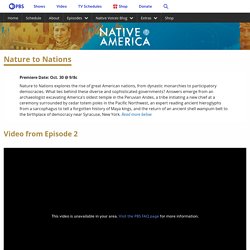
What lies behind these diverse and sophisticated governments? Native America. At the intersection of Native knowledge and modern scholarship is a new vision of America and its people.
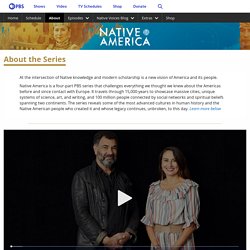
Native America is a four-part PBS series that challenges everything we thought we knew about the Americas before and since contact with Europe. It travels through 15,000-years to showcase massive cities, unique systems of science, art, and writing, and 100 million people connected by social networks and spiritual beliefs spanning two continents. NATIVE AMERICA. Watch Native-American History: Native American Influence On The US. Infinity of Nations: Art and History in the Collections of the National Museum of the American Indian - George Gustav Heye Center, New York. The history of the Woodlands—the United States and southern Canada east of the Mississippi River and along the shores of the Great Lakes—spans a remarkable depth of time.
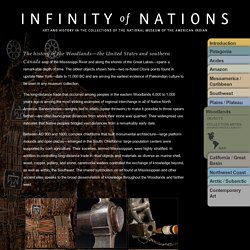
The oldest objects shown here—two re-fluted Clovis points found in upstate New York—date to 11,000 BC and are among the earliest evidence of Paleoindian culture to be seen in any museum collection. The long-distance trade that occurred among peoples in the eastern Woodlands 6,000 to 1,000 years ago is among the most striking examples of regional interchange in all of Native North America. Bannerstones—weights tied to atlatls (spear-throwers) to make it possible to throw spears farther—are often found great distances from where their stone was quarried. Their widespread use indicates that Native peoples bridged vast distances from a remarkably early date.
Between AD 900 and 1600, complex chiefdoms that built monumental architecture—large platform mounds and open plazas—emerged in the South. Nation to Nation. Featured Collections. Environmental Art Holdings related to climate and the environment include contemporary photographs by Diane Burko, Edward Burtynsky, J Henry Fair, and Emmet Gowin, among others, as well as painted landscapes and studies for Christo's Running Fence.
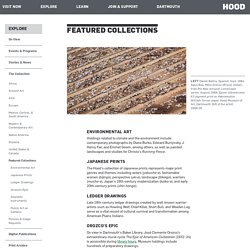
Japanese Prints The Hood's collection of Japanese prints represents major print genres and themes, including actors (yakusha-e), fashionable women (bijinga), perspective (uki-e), landscape (fūkeiga), warriors (musha-e), Japan's 19th-century modernization (kaika-e), and early 20th-century prints (shin hanga). Ledger Drawings Late 19th-century ledger drawings created by well-known warrior-artists such as Howling Wolf, Chief Killer, Short Bull, and Wooden Leg serve as a vital record of cultural survival and transformation among American Plains Indians. Native American Cultures - Facts, Regions & Tribes. Many thousands of years before Christopher Columbus’ ships landed in the Bahamas, a different group of people discovered America: the nomadic ancestors of modern Native Americans who hiked over a “land bridge” from Asia to what is now Alaska more than 12,000 years ago.

In fact, by the time European adventurers arrived in the 15th century A.D., scholars estimate that more than 50 million people were already living in the Americas. Of these, some 10 million lived in the area that would become the United States. As time passed, these migrants and their descendants pushed south and east, adapting as they went. In order to keep track of these diverse groups, anthropologists and geographers have divided them into “culture areas,” or rough groupings of contiguous peoples who shared similar habitats and characteristics. Native American societies before contact. Native American societies before contact. 16 maps that Americans don't like to talk about. If there was a single moment when the US became a global power, it was the war with Spain.
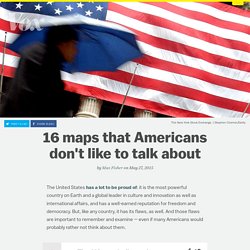
The Spanish Empire had been crumbling for a century, and there was a ferocious debate within the US over whether America should replace it as a European-style imperial power, or if as a democracy the US should instead liberate peoples from imperialism. The debate centered on Cuba: pro-imperialists wanted to purchase or annex it from Spain (pre-1861, the plan was to turn it into a new slave state); anti-imperialists wanted to support Cuban independence.
In 1898, Cuban activists launched a war of independence from Spain, and the US intervened on their side. Native American Clashes with European Settlers. Native American Clashes with European Settlers Emergence of Tribes By 1600, organized tribes such as the Delaware and Shawnee had moved into present-day West Virginia.

In addition, the powerful Iroquois Confederacy began exerting its influence on the region. The Confederacy was an alliance of five Iroquois-speaking nations -- Mohawk, Oneida, Onondaga, Cayuga, and Seneca -- formed in present-day New York in the late 1500s. In 1722, the Tuscaroras joined the Iroquois Confederacy, which became known as the Six Nations. When Europeans first explored western Virginia in the late 1600s, they discovered few Native Americans. The Moundbuilder Myth Debunked. The Moundbuilder myth is a story believed, wholeheartedly, by Euroamericans in North America well into the last decades of the 19th and even into the 20th century.

The central myth was that indigenous people who lived in what is today the United States were incapable of engineering of the thousands of prehistoric earthworks found by the newcomers and must have been built by some other race of people. That myth served as justification for the plan to exterminate Native Americans and take their property. It was debunked in the late 19th century. Key Takeaways: Moundbuilder Myth. The Map Of Native American Tribes You've Never Seen Before : Code Switch : NPR.
The Mashantucket (Western) Pequot Tribal Nation. The history of the Mashantucket Pequot Tribal Nation is one of dramatically changing fortunes.

Native peoples have continuously occupied Mashantucket in Southeastern Connecticut for over 10,000 years. By the early 17th century, just prior to European contact, the Pequots had approximately 8,000 members and inhabited 250 square miles. War and Peace with Powhatan's People. Despite his suspicions, Chief Powhatan helped the British settlers through their first winters.
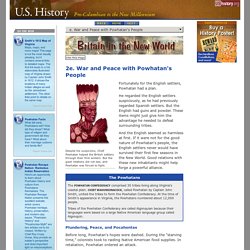
But the good relations did not last, and Powhatan was forced to fight. Fortunately for the English settlers, Powhatan had a plan. He regarded the English settlers suspiciously, as he had previously regarded Spanish settlers. Powhatan Confederacy. POWHATAN CONFEDERACY, a paramount chiefdom in the coastal plain of Virginia, named for its leader at the time of English colonization. Powhatan had inherited the leadership of a group of six tribes in the sixteenth century and expanded his authority to more than thirty tribes by 1607. Much of this expansion was by conquest. The Powhatans had a system of dual leadership with a "peace chief" responsible for internal affairs and a "war chief" for external affairs, including warfare.
There was also a powerful council, which included priests and other advisers. Central Rappahannock Regional Library. Eastern Siouan, Eastern Blackfoot Descendants. Said by Gerard to signify "falls in a current of water," and applied originally to one tribe but extended by the English to its chief Wahunsonacock, and through him to the body of tribes which came under his sway.
Also called: Haudenosaunee (Iroquois) Guide for Educators. 1: American Indian CulturesCulture is a result of human socialization. People acquire knowledge and values by interacting with other people through common language, place, and community. In the Americas, there is vast cultural diversity among more than 2,000 tribal groups. Tribes have unique cultures and ways of life that span history from time immemorial to the present day. The Powhatan Indian World - Historic Jamestowne Part of Colonial National Historical Park. Bibliography Breed, Allen. "Virginia Indians balk at Jamestown Anniversary without Recognition. " HamptonRoads.com. 12/26/2005. Web. 22 May 2008. Dilday, Robert. Egloff, Keith and Deborah Woodward. Fiske, Warren. Gleach, Frederic W. Mapping History : European Exploration and Early Settlement 1492-1700 - North America in 1700. Mapping History : Native American Tribes 1783 - Native American Tribes 1783. Indigenous Peoples' Day 2019.
American Revolution — FAQs. History. Native Americans and the American Revolution: Choosing Sides. Revolutionary Limits: Native Americans. Native Americans in the Revolutionary War. Virtual Jamestown. Samuel Collier - Historic Jamestowne Part of Colonial National Historical Park. Virginia Indian Archive. Geolocation Title What Pocahontas Saw Description. Jamestown: What Pocahontas Saw. Geolocation Title Jamestown: What Pocahontas Saw. The True Story of Pocahontas. Pocahontas might be a household name, but the true story of her short but powerful life has been buried in myths that have persisted since the 17th century.
To start with, Pocahontas wasn’t even her actual name. Born about 1596, her real name was Amonute, and she also had the more private name Matoaka. Pocahontas was her nickname, which depending on who you ask means “playful one” or “ill-behaved child.” New Jamestown Discovery Reveals the Identities of Four Prominent Settlers. Native American Society on the Eve of British Colonization. The Anasazi pottery seen here has been dated between 1000 and 1300 C.E. Indigenous Geographies Overlap in This Colorful Online Map. For centuries, Indigenous peoples and their traditional territories have been purposefully left off maps by colonizers as part of a sustained campaign to delegitimize their existence and land claims. Explore Lesson Plans & Resources. Essential Understandings Framework. Essential Understandings The National Museum of the American Indian (NMAI) Native Knowledge 360° Essential Understandings about American Indians is a framework that offers new possibilities for creating student learning experiences.
Teaching with Primary Sources. Honoring tribal legacies 1.